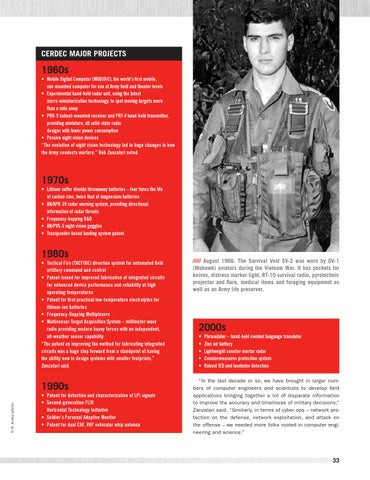cerdec Major Projects
1960s
• Mobile Digital Computer (MOBIDIC), the world’s first mobile, van-mounted computer for use at Army field and theater levels • Experimental hand-held radar unit, using the latest micro-miniaturization technology, to spot moving targets more than a mile away • PRR-9 helmet-mounted receiver and PRT-4 hand-held transmitter, providing miniature, all solid-state radio designs with lower power consumption • Passive night vision devices “The evolution of night vision technology led to huge changes in how the Army conducts warfare,” Bob Zanzalari noted.
1970s
• L ithium sulfur dioxide throwaway batteries – four times the life of carbon-zinc, twice that of magnesium batteries • AN/APR-39 radar warning system, providing directional information of radar threats • Frequency-hopping R&D • AN/PVS-5 night vision goggles • Transponder-based landing system patent
U.S. Army photo
1980s
• T actical Fire (TACFIRE) direction system for automated field artillery command and control • Patent issued for improved fabrication of integrated circuits for enhanced device performance and reliability at high operating temperatures • Patent for first practical low-temperature electrolytes for lithium-ion batteries • Frequency-Hopping Multiplexers • Multisensor Target Acquisition System – millimeter wave radio providing modern heavy forces with an independent, all-weather sensor capability “The patent on improving the method for fabricating integrated circuits was a huge step forward from a standpoint of having the ability now to design systems with smaller footprints,” Zanzalari said.
///// August 1966. The Survival Vest SV-2 was worn by OV-1 (Mohawk) aviators during the Vietnam War. It has pockets for knives, distress marker light, RT-10 survival radio, pyrotechnic projector and flare, medical items and foraging equipment as well as an Army life preserver.
1990s
“In the last decade or so, we have brought in larger numbers of computer engineers and scientists to develop field applications bringing together a lot of disparate information to improve the accuracy and timeliness of military decisions,” Zanzalari said. “Similarly, in terms of cyber ops – network protection on the defense, network exploitation, and attack on the offense – we needed more folks rooted in computer engineering and science.”
• Patent for detection and characterization of LPI signals • Second-generation FLIR Horizontal Technology Initiative • Soldier’s Personal Adaptive Monitor • Patent for dual EHF, VHF vehicular whip antenna
2000s • • • • •
Phraselator – hand-held combat language translator Zinc air battery Lightweight counter-mortar radar Countermeasures protection system Robust IED and landmine detection
33
